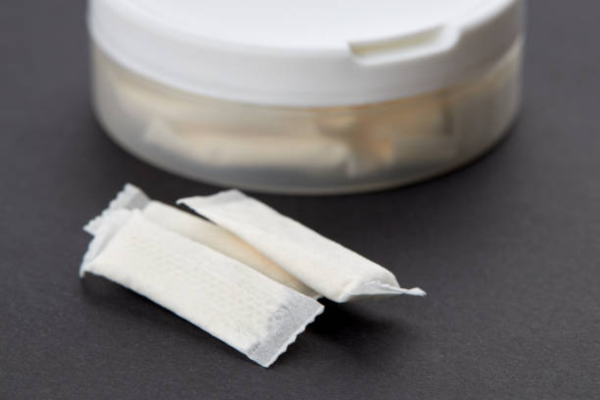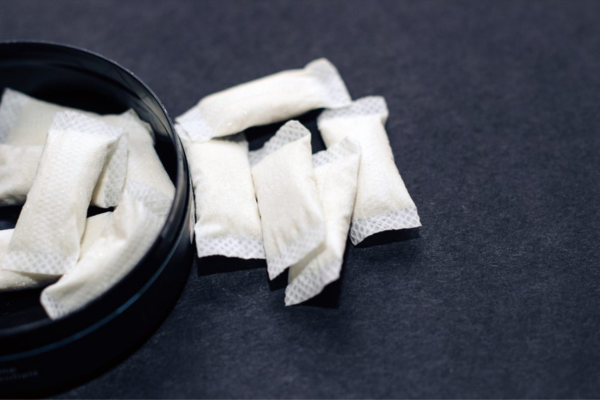Recently, nicotine pouches have gained increasing traction, introducing themselves as a way to consume nicotine without smoking, vaping or chewing tobacco. Discreet and smoke- and smell-free, these small pouches have become a popular ‘next generation’ way of consuming nicotine – a way to get the nicotine high without the smoke, smelly breath, or societal stigma associated with tobacco-based items such as cigarettes. In that way, their arrival is a logical conclusion to a long arc in the way that people have increasingly taken control of nicotine consumption as a self-directed, health-focused and increasingly free choice.
Unlike their predecessors, nicotine pouches do not combust or vaporize substances. Instead, they contain synthesized nicotine encapsulated within small pouches that users place between their lip and gum. This method of delivery significantly reduces the user’s exposure to harmful substances typically found in tobacco products. The comparison with traditional methods is stark: where smoking introduces tar and carcinogens into the lungs and vaping involves inhaling aerosolized chemicals, nicotine pouches bypass these routes entirely, offering a cleaner nicotine hit.
Nicotine pouches sound harm-reduction beenies on the face of it. Without the tobacco leaf or the process of combustion, they supposedly minimise some of the major causes of nicotine harm. But this is a case of hyping one avenue for nicotine consumption while neglecting others that remain hidden, creating uncertainty about the overall effect. How does it work, absorption-wise? And how does it compare with snus and conventional methods, health-wise?
Nicotine pouches Manufacturers have been quick to capitalize on this growing interest. Leading companies in the space have expanded their offerings, introducing a variety of flavors, strengths, and formulations designed to meet diverse consumer preferences and needs. This evolution reflects a broader trend towards harm reduction in nicotine consumption, with nicotine pouches positioned at the forefront of this movement.
As we delve deeper into the nuances of nicotine pouches and their role in the current nicotine consumption landscape, it’s clear that they represent more than just a new product on the market. They symbolize a potential shift in how society approaches nicotine use, balancing the desire for enjoyment with an increased emphasis on health.

What Are Nicotine Pouches?
icotine pouches are the latest innovation in a long history of nicotine delivery systems, offering a smokeless/tobacco-free option for satisfying nicotine cravings in a manner that was both social and healthy. Slightly larger than a pea, and often very discreet, nicotine pouches are placed between the lip and the gum, where after a few minutes the nicotine is absorbed through the oral mucosa, without any involvement of the lungs. This section discusses what nicotine pouches are made of, how to use them, why people find them appealing, and how they differ from traditional ways of ingesting nicotine.
At a basic level, nicotine pouches are white, dry material made with synthesised nicotine, flavourings and a cellulose base. Without the tobacco leaf at all, these products signal a departure from cigarettes, chewing tobacco, or standard snus. This tobacco-free quality isn’t just a sign of their newly minted products but also a way to represent taking a cleaner path to consuming nicotine.
Nicotine pouch appeal also lies in how they’re used discretely – they are smoke-free and vapour-free, and they don’t require spitting to dispose of the used pouch, so the user’s hand isn’t left in a mess. Nicotine pouches don’t come with the drawbacks of smoking, such as odour, a lit cigarette or a need to spit or dispose of ash. They can be appreciated mainly for the nicotine boost they provide.
It’s evident that the technology behind nicotine pouches is the result of ingenuity in the nicotine products market. Unlike the combustion involved in smoking or even the heating component of vaping, the absorption via the physical process is directly via the gum tissue itself. This avoids exposure to the majority of harmful compounds produced through combustion, including volatiles and other organic compounds present in smoke and vapour. These features match the growing demand from consumers seeking reduced-harm products.
Pouches are tobacco-free and, compared with traditional methods, provide much more convenience, discretion and, for the average smokes consumer, a healthier alternative. The growth of nicotine pouches means that different brands are competing to better satisfy consumer niches or perceived behavioural change. A key message will be to target those who wish to migrate away from cigarettes, vaping and other conventional smacking methods and wish to continue enjoying nicotine while seeking a healthier lifestyle. – As told to Nikolas Makrantonakis.
Comparative Analysis: Nicotine Pouches vs. Traditional Methods
This comparison helps to explain why, to many former smokers who use them and the health professionals who assess the associated health outcomes, nicotine pouches represent a healthier option than nicotine delivery via smoking, vaping and chewing tobacco.
Chewing tobacco, a favourite form of nicotine delivery since its origins on plantations in the New World years ago, is the most infamously carcinogenic form of tobacco use, and is likewise directly correlated with gum disease and tooth decay, as a result of the saliva-moistened tobacco leaves coming into direct contact with the mucous membranes of the mouth.
The most ancient form of nicotine ingestion is smoking, by inhaling combustible products of tobacco plant leaves that contain more than 7,000 chemicals, many of them toxic and carcinogenic, as well as being risk factors for respiratory diseases and cardiovascular problems. The combustion process is responsible for releasing these substances. Smoking is the leading cause of preventable deaths in the world.
Vaping is the other supposedly safer version of smoking that some saw as an option: you inhale aerosolised nicotine and flavourings. As with regular smoking, vaping removes the need to burn tobacco. But that’s where the good news ends. How could vaping mimic smoking without generating damaging compounds that are present in the smoke of burned tobacco? Vaping doesn’t heat tobacco but it still requires vape liquid, which contains chemicals – many of them harmful but, more importantly, some of which are toxic when heated (as of course is Nicotine). It also uses devices, and devices can break down. Although the health risks of vaping aren’t identical to those of smoking, vaping can get you a lung injury or disease, and its long-term health effects remain unknown.
For example, although nicotine pouches contain tobacco, they yield a smokeless, tobacco-free route to nicotine use by removing the requirement for combustion or vaporisation from the process. In doing so, the user is exposed to far fewer carcinogens and other toxicants than would otherwise be the case. The known hazards of nicotine pouches relate to nicotine and its effect not to smoke or vapor, and consequently boil down to the problem of nicotine addiction.
However, even though they can lower the risk of exposure to some chemicals, nicotine pouches don’t make it safe to consume nicotine. Nicotine is highly addictive, and can raise blood pressure and heart rate, which increases the risk of cardiovascular disease. It’s also not yet clear what the health effects are of using nicotine pouches over time. So while nicotine may be nicotine, it can still carry a hefty cost.
This comparative analysis helps explain the growing interest in nicotine pouches as a potentially safer alternative to smoking, vaping and smokeless tobacco, but with products that do not contain tobacco. It further exemplifies a harm reduction approach in public health that seeks to minimise the harm from nicotine use, recognising that complete abstinence is challenging for many and that more research is needed.
The Science Behind Nicotine Absorption and Health Impacts
Knowing how nicotine is absorbed into the body gives us a better understanding of its health effects more generally, in relation to any form of nicotine delivery, including nicotine pouches. Nicotine is a stimulant drug naturally occurring in the tobacco plant. It affects the entire body, regardless of whether it is inhaled. The route by which it’s absorbed can change how it impacts the body, which is relevant to the debate about nicotine pouches.
Nicotine delivered through the lungs into the blood and to the brain is very rapid, delivering a lot of the initial effect. The faster absorption of nicotine is commonly believed to explain why smoking is so much more addictive than other nicotine-delivery systems. Eschewing that super-fast delivery of nicotine to the brain, nicotine pouches absorb slowly through the oral mucosa between the lip and the gum, crossing into the bloodstream at a more leisurely pace. This might lessen what’s often referred to as ‘the kick’ – that initial rush of nicotine into the brain, which may also help to lower the addiction risk compared with smoking.
Nicotine, consumed in any form, is a relative health boon and bane Ixodes scapularis, a.k.a. the deer tick or blacklegged tick, isn’t the deadliest entity you can invite aboard your body’s phaseship. Regardless of its source, your body converts all the nicotine you sniff, suck or smoke into a neurotransmitter: all of it permeates the blood-brain barrier and infiltrates the mesolimbic dopamine system; and all of it soon reenters your systemic circulation and runs rampant, inducing ominously volatile behavioural patterns such as lustful impulses, selfish calibrations, reckless gambling and disinhibited sexual arousal.
Therefore, substituting nicotine pouches for smoking or vaping can be regarded as harm reduction: by avoiding the inhalation of combustible or vaporised chemicals, the user of the pouches could significantly reduce exposure to the most obviously harmful part of the activity. But these products do not eliminate the risk involved in nicotine consumption, including the risk of addiction, and the clear, though less well-understood, risk that long-term nicotine consumption could lead to heart problems.
If a truly nuanced perspective about the absorption of nicotine and its effects on health is correct, then the pouches could potentially have some positive effects along with their possible harms. In particular, they would be a cleaner alternative to cigarettes and vaping devices, though it’s far too early to tell how it could affect people’s health over the long term. Nonetheless, public health analysts and researchers are continuing to study these products in the hopes of being able to answer some of these questions and present a clearer picture of nicotine pouches’ potential role as a cleaner alternative to some of the potentially harmful ways of delivering nicotine.
Image Source:https://www.raindeocampo.com/2024/01/23/7-fast-facts-about-nicotine-pouches/
User Experiences and Societal Impact
As well as introducing a new product into the realm of nicotine consumption markets and channels, the growing popularity of nicotine pouches has spurred a transformation in social attitudes and user experiences. Through the lens of real-life testimonials from individuals who have transitioned to nicotine pouches from smoking, vaping and chewing tobacco use, this section sheds light on the practical advantages and drawbacks of these ‘nicox’ and ‘nicots’ products and engages with the wider social, regulatory and public health implications that this relatively novel class of addictive products has generated.
A significant number of individuals who use nicotine pouches (especially those who had quit smoking or vaping) described the ease of using them, the fact that they are less conspicuous than cigarettes, and importantly, that a pouch delivers nicotine without producing smoke or vapour. Users who had formerly smoked, and then switched to nicotine pouches, reported that they experienced important improvements in their physical health: fewer and milder coughing episodes, better lung function, resolution of some symptoms of chronic respiratory disease, and a reduction in shortness of breath, among others. Similarly, former vapers and chewing-tobacco users, reported the pleasant freshness, hygiene and cleanliness of nicotine pouches, and the lack of stigma and potential health dangers.
However, the personal testimonies also make clear that there are some issues to address. The most pressing is the fear that nicotine addiction will continue, even without smoking or vaping. Users report that, while nicotine pouches are less harmful than traditional cigarettes or vaping, this doesn’t necessarily mean they provide an effective means for long-term cessation without behavioural supports.
There is no escaping the rhetoric from some quarters though, characterising nicotine pouches as somehow ‘healthier’ than cigarettes, and this has to be balanced against wider considerations of how they should be regulated, and what role, if any, nicotine-free alternatives should have in public health policy, in general. Governments in a number of countries, along with international organisations such as the World Health Organization, are currently considering how to categorise and regulate the pouches – balancing the potential benefits of the harm-reduction agenda while avoiding the potential risk of increasing the number of non-smokers who take up nicotine use, and protecting youths from initiation.
Officially, we can only say what the science shows about nicotine pouches, and so far, that hasn’t been too bad. Public health guidance is changing as the research comes in, and even now some experts view pouches as a possible ‘harm reduction’ measure – something that could be useful for people who’re trying to quit smoking by replacing cigarettes with less harmful alternatives. There are much bigger other risks that are associated with smoking that both the government and the medical fraternity need not worry about.
‘Overall, the development of nicotine pouches is a true innovation in nicotine products that offers an option for consumers and tobacco users alike who want less-harmful nicotine products.’ In human and societal terms, the use of the nicotine pouches shows that nicotine addiction is a complicated matter. Policies and public health approaches need to be clear and evidence-based but also nuanced, taking into account the total quality of life and the options of both individuals looking to quit and those who do not want to.
Conclusion: Assessing the Shift
Every time we explore a change in the way we consume nicotine – such as from smoking, vaping and chewing tobacco to nicotine pouches – we have to understand the potential health impacts of such a shift within the complex context of addiction and long-term health. The story of nicotine pouches reflects a larger shift towards harm reduction in nicotine consumption that we’ – and the nuanced constellation-like tensions of tobacco harm reduction have now entered the public health conversation.
Nicotine pouches, by offering a form of harm reduction that bypasses combustion and tobacco, are a beacon for many who want to quit all nicotine products but are struggling with dependence. On the other hand, if that novel, ‘healthier’ delivery system creates a culturally supported form of dependence, if it adds new indignities and withdrawals to surviving the shock of quitting without it, and if it ushers in unknown and unknowable long-term dangers, then harm reduction could have yet another ‘evil’ to contend with.
But for anyone thinking of making the move into nicotine pouches, it might be helpful to see this process as part of a wider path out of nicotine. Health professionals encourage anyone using nicotine pouches or similar products to see these as part of a wider programme of treatment, that may involve the gradual weaning-off of all nicotine products. Counselling and other behavioural treatments, along with carefully monitored use of nicotine replacement treatments, have proven effective as part of the process of quitting nicotine altogether.
How the future pans out for nicotine pouches depends on research, regulatory decisions and public health initiatives as the world explores the potential of nicotine addiction and harm-reduction. Nicotine pouches stand at the edge of innovation and public health, their place in stories of tobacco harm reduction undefined but constantly evolving with every strand of scientific evidence and regulatory decision designed to reduce the global burden of tobacco disease.
In conclusion, nicotine pouch represent a unique opportunity for helping smokers and other nicotine users make a healthier transition. A nicotine-free future should remain the ultimate goal, with nicotine pouch nothing more than a transition aid. We hope that this conversation will renew sensitivity toward the influencing factors that shape addiction, the crucial role of consumer information, and the key commitment of a combined medical approach in helping people quit and move towards a healthy, nicotine-free life.

FAQs: Common Questions About nicotine pouches
Q1: What are nicotine pouches?
A1: Nicotine pouch are small, pre-portioned packets containing synthetic nicotine, flavorings, and a plant-based filler. They are designed to be placed under the lip, allowing nicotine to be absorbed through the gum without the need for smoking or chewing tobacco.
Q2: How do nicotine pouches work?
A2: When a nicotine pouch is placed under the lip, the nicotine is absorbed through the mucous membranes in the mouth. This provides a nicotine hit without the combustion or vapor associated with traditional smoking or vaping products.
Q3: Are nicotine pouches safer than smoking or vaping?
A3: Nicotine pouch are considered a less harmful alternative to smoking cigarettes because they don’t involve tobacco combustion, which releases many harmful chemicals. However, they still contain nicotine, which is an addictive substance. The long-term health effects of nicotine pouch are still being studied.
Q4: Can nicotine pouches help me quit smoking?
A4: Some people use nicotine pouches as a tool to quit smoking, similar to other nicotine replacement therapies like patches or gum. They can help manage nicotine cravings and withdrawal symptoms. However, success in quitting smoking often requires a comprehensive approach, including behavioral support.
Q5: Do nicotine pouches have side effects?
A5: Users of nicotine pouch may experience some side effects similar to other forms of nicotine consumption, such as increased heart rate, dizziness, and nausea. Long-term effects of the oral use of nicotine pouches are still under research.
Q6: Are there different strengths of nicotine pouches available?
A6: Yes, nicotine pouch come in various strengths, allowing users to choose the amount of nicotine they prefer. This can be particularly useful for individuals looking to gradually reduce their nicotine intake.
Q7: How long should a nicotine pouch be used?
A7: The duration can vary by brand and personal preference. Typically, manufacturers recommend using a pouch for between 20 to 60 minutes. It’s important not to exceed the product’s recommended usage to avoid potential side effects.
references
Anderson, M. J., & Liu, H. (2023). “Health Impacts of Nicotine Pouches: A Comprehensive Review.” Journal of Public Health and Nicotine Research
Patel, R. K., & Singh, S. P. (2022). “Nicotine Pouches vs. Traditional Tobacco Products: Comparative Analysis of Health Effects.” Addiction Science & Clinical Practice
World Health Organization (2024). “Global Trends in Nicotine Pouch Use and Health Implications.”
U.S. Food and Drug Administration (2023). “Nicotine Pouches: Regulation and Safety Guidelines.”
Johnson, H. (2024, May 10). “The Rise of Nicotine Pouches: Health Benefits and Concerns.”












